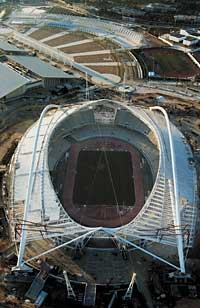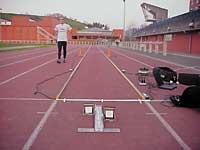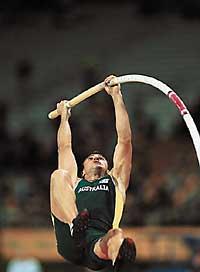Science and technology in all areas of sport

As recently seen in Athens, stadiums are the most prominent meeting point for elite athletes. The current stadiums do not resemble those of a time. The Olympic Games were held in London in 1908. The track had a perimeter of 536.45 meters. Inside it had swimming pool and another wooden track.
Athletics, cycling and swimming were tested. In 1912 it dominated in Stockholm and in 1920 in Antwerp a similar trend. The Americans, in order to give a new image to the Games, prepared a building similar to that of the Roman coliseum for the Los Angeles Games of 1932. Under Hitler's orders, the architecture giant of the Olympic Games took a new step and the Nazis built a concrete stadium with capacity for 120,000 people.
Subsequently, the stadiums of the Olympic Games have had grandeur and courage until the construction of singular buildings. The futuristic stadium of Munich, the brave architecture of Montreal, the entrainment and practicality of Moscow, which allowed its use in winter, the recyclable stadium of Atlanta, the spectacularity of Sidney... all of them as an example of architectural progress.
Evolution of facilities
They are not decisive in improving brands, but they can help facilities. Therefore, it is not surprising that there have been great changes in time on tracks and sports fields.
At the 1896 Athens Games, the track was ash. It was almost 75 years before he left the ash and began to use the tartan on the track. Tartana is a synthetic resin. It was placed either by sheets or by pouring on the concrete. He revolutionized athletics and quickly spread around the world. The red color of the tartana replaced the black ash tracks. Unlike the ash, the tartan was flexible, elastic, with rain no water wells were formed, did not stick to footwear, nor the knife.

Currently different types of resins are used, of different characteristics, depending on what you want to achieve: hard for speed race, more flexible for jumps, rough for launches, etc. Of course, resins have also jumped from athletics to other sports.
New materials
The evolution of athletic tracks has been accompanied by the evolution of the different instruments used in this type of spaces. One of the most representative are the starting-blocks, supports used in the output of speed races. In the Games of the beginning of the last century the runners were standing up, nor bending down to catch the push. In 1896, Europeans stared at Americans who knelt on the running track.
They are not those of then the exit drawers. When Jesse Owens surprised Hitler in Berlin, he had to make holes in the ash track. By then they knew each other. In 1948 they first appeared at the London Olympics. Later they have been placed sliding rails, have speakers to listen to the orders of judges and electronic devices to detect too fast outputs. If the reaction time of athletes is less than one hundred thousandths, the output is considered bad. Other sports, such as swimming, use the same basic system both on departure and arrival.
They are more than athletic tracks, but they are sports fields. Golf, football and hockey are outdoor sports on grass fields, while the fields are not in a natural state.

The selection and preparation of herbaceous species in laboratories, the installation of drainage systems, the type of herbs and construction depending on sport, irrigation systems and conservation work are increasingly complicated, as well as the use of artificial grass. The artificial grass consists of remains, rubber and plastic. From the point of view of the game is not as sweet as natural, but you have to do less work to take care of it. And, of course, it has other aesthetic possibilities, as it can be easily painted.
Measuring systems
Reaction time has been mentioned above, which is directly related to measurement systems. From the use of feet to measure distances, including the meter, they have come to use electronic devices, such as the length jump, although then use the measuring tape to check it. Watches, chronometers, anemometer, photofinish... all have followed the same path: make more accurate measurements. It is difficult to say how far you can go, but if necessary, the technique is ready to measure up to 10,000 per second.
In some sports, the photofinish decides the winner. Before it was decided by eye, but today it would be impossible, the eye does not have that precision.
He began playing sports in the 1950s. The photofinish is a device made up of a photographic apparatus and a quartz watch. The photo machine is at the height of the target line and when the watch is launched it also starts working. At the top of the camera film are taken pictures of the goal and at the bottom takes time. The vertical line of the image provides the athlete's real time. Today you can also watch these images on TV, and with slow cameras viewers can also do it.
Sports equipment

In the equipment there has also been a dizzying change, it often seems that athletes are not dressed but dressed. Slippery skiers' suits, runners' suits that barely resist the air (remember Florence Griffith-Joyner's look at the Seoul Games? ), the jerseys used by the US Postal group in the time trial of the last Tour, the light and hot materials used in the mountain, do not wet, but that expel sweat, have been converted into Leftlikona, etc.
So much can be said of shoes. How many –tex already there? And the shoes that Adidas has presented this year? They have exceeded all limits: they are electronic, have microprocessor to adjust the cushioning of the shoe to the height and weight of the athlete. Synthetic fibres, microspeakers and production techniques are responsible for these advances.
In sports that use some tool evolution has been spectacular. Formula 1 cars, motorcycles, bicycles, helmets... All have changed and some have changed year after year.
Many of them are obvious, but others are less known. For example, the javelin used in athletics. Until 1952 they were used in metal or wood. That year, the American Buld Held presented an innovative design: the wooden javelin. Thanks to this, maintaining the weight, he used javelin of greater section, and therefore with a greater containment plane. In addition, at its end a small metal tip was placed to change the center of gravity.
With this javelin the limit of 80 meters broke for the first time. Evolution, however, did not remain there. The following year Helde himself replaced wood with aluminum, a much more stable material. It reached 81.55 meters and shot 14 centimeters more than the previous year.

Later the shape of the soaps was changed, especially with a sharper background. As marks of more than one hundred meters were obtained and the stadiums could not be extended, limits were established to the soaps, which had to be heavier and which had to have the center of gravity later, so that they were falling from top to bottom. Records went back about 20 meters. However, the small changes that have occurred in recent times respecting the norm have allowed the record to be around one hundred meters.
On the pole jump you can tell a similar story, because thanks to alloys and synthetic fibers athletes have been gaining height. Like tennis rackets, ping-pong sticks, golf clubs, soccer balls... And the computer simulators that have been launched lately, the tools that monitor body fluctuations during work, the energy foods that are produced especially for athletes, etc., also serve to write, since in sport there is no scientific and technological impact.





